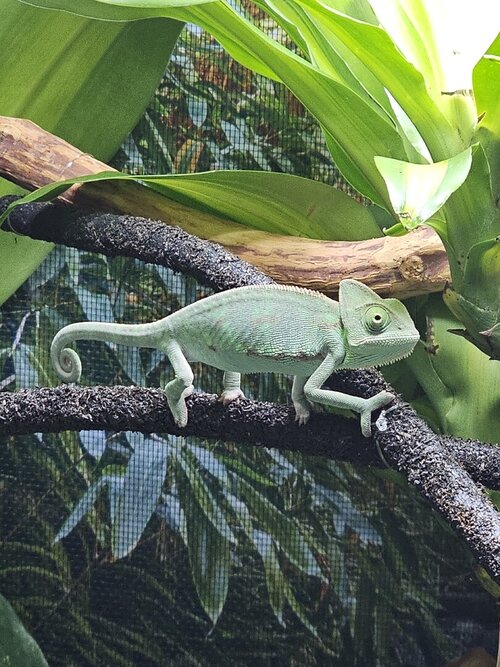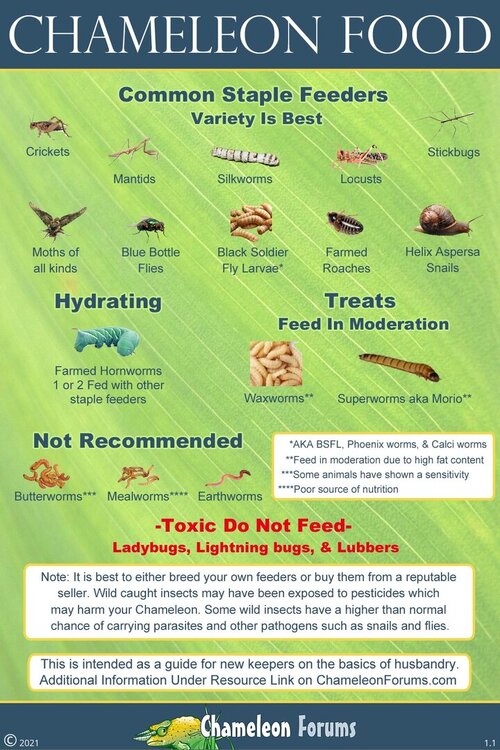Hello, thanks for stopping by and checking out our veiled chameleon and her enclosure. We did so much research and try to find the best solution for this beautiful cham. We are first timers and learning with her as we go. We would like tips, advices, and love for our little girl. She's about anywhere from 4-5 months, not sure still. Her enclosure has 2 live plants, 1 vine, 4 sticks to move around, feeder, uvb 5.0 and a 50w basking spot. We temporarily use a water bottle for her dripper. Food at the moment is meal worms and dubia roaches, any tips on food and feeding? thank you!!! But how does she look!?!?
Navigation
Install the app
How to install the app on iOS
Follow along with the video below to see how to install our site as a web app on your home screen.
Note: This feature may not be available in some browsers.
More options
You are using an out of date browser. It may not display this or other websites correctly.
You should upgrade or use an alternative browser.
You should upgrade or use an alternative browser.
New owners! First Veiled chameleon!
- Thread starter NyKo
- Start date
ehdee6
Chameleon Enthusiast
Welcome to the forum! That's a healthy looking little girl, she looks on the younger side of 4 months. Did you name her?
Because she's female she'll need a bit of tweaking in her husbandry compared to males. Some of the best information for keeping our little girls is in this blog:
https://www.chameleonforums.com/blogs/veiled-chameleon-laying-101.2488/
Are you hand misting her? I just noticed your cage is really close to the wall, which isn't a problem. I'd just hate to see the wall get water damaged, if the screen isn't covered with something.
Otherwise; all I can add is make sure she has a bin to lay her eggs, and more sticks are always better. With food, offering more variety when they're young is optimal. Unfortunately, mealworms aren't very nutritious. I've attached a picture of the best feeder options at the bottom.
If you'd like a full husbandry review feel free to answer the following:
You can just copy and paste with your answers.
Chameleon Info:
--------------
Please Note:
Because she's female she'll need a bit of tweaking in her husbandry compared to males. Some of the best information for keeping our little girls is in this blog:
https://www.chameleonforums.com/blogs/veiled-chameleon-laying-101.2488/
Are you hand misting her? I just noticed your cage is really close to the wall, which isn't a problem. I'd just hate to see the wall get water damaged, if the screen isn't covered with something.
Otherwise; all I can add is make sure she has a bin to lay her eggs, and more sticks are always better. With food, offering more variety when they're young is optimal. Unfortunately, mealworms aren't very nutritious. I've attached a picture of the best feeder options at the bottom.
If you'd like a full husbandry review feel free to answer the following:
You can just copy and paste with your answers.
Chameleon Info:
- Your Chameleon - The species, sex, and age of your chameleon. How long has it been in your care?
- Handling - How often do you handle your chameleon?
- Feeding - What are you feeding your cham? What amount? What is the schedule? How are you gut-loading your feeders?
- Supplements - What brand and type of calcium and vitamin products are you dusting your feeders with and what is the schedule?
- Watering - What kind of watering technique do you use? How often and how long to you mist? Do you see your chameleon drinking?
- Fecal Description - Briefly note colors and consistency from recent droppings. Has this chameleon ever been tested for parasites?
- History - Any previous information about your cham that might be useful to others when trying to help you.
- Cage Type - Describe your cage (Glass, Screen, Combo?) What are the dimensions?
- Lighting - What brand, model, and types of lighting are you using? What is your daily lighting schedule?
- Temperature - What temp range have you created (cage floor to basking spot)? Lowest overnight temp? How do you measure these temps?
- Humidity - What are your humidity levels? How are you creating and maintaining these levels? What do you use to measure humidity?
- Plants - Are you using live plants? If so, what kind?
- Placement - Where is your cage located? Is it near any fans, air vents, or high traffic areas? At what height is the top of the cage relative to your room floor?
- Location - Where are you geographically located?
--------------
Please Note:
- The more details you provide the better and more accurate help you will receive.
- Photos can be very helpful.
Attachments
LizardLurkin
Avid Member
I don't want to detract you from ehdee's husbandry form, but I will also add, on top of the image of feeders they shared, here is a helpful guide for gutloading said feeders. Now, bugs like silkworms and hornworms often come with their own chow, wax worms are fed before purchasing, and some people forego feeding their BSFL, so really you're only gutloading the crickets and the roaches. Personally I throw a little bit of leftover gutload from my roaches into the BSFL container here and there, just to keep them happy.

This is a helpful video that will introduce you to the great concept of gutload ice cubes, which makes gutloading a lot easier for me: www.youtube.com/watch?v=NKtj5N6SnG8
You can make two trays and they'll last for months in the freezer. My current gutload consists of mostly collard greens, butternut squash, a little bit of banana, and a 1/4 teaspoon of bee pollen. What I do is, the night prior, I grab my roaches, put em in a feeder cup with a bit of the gutload ice cube shaved off, and cover them and let them eat while I'm asleep. Then the next morning they are gutloaded and more nutritious for the chameleon.
I'd also recommend that you keep your roaches fed by other means aside from the gutload. I only feed the gutload ice cubes to those selected the night prior, and they're otherwise fed repashy bug burger and dry roach chow. Similarly, I prepare a cup of bug burger (with two cups water), freeze it, and it lasts a long time.
As for protecting your wall from water damage, here is a cheap and easy method of converting her enclosure into a hybrid enclosure. The moisture stays in, but the front, top and bottom screens are still open to create the chimney effect:
Your girl is so beautiful and cute! Her current enclosure looks to be of a smaller size, so do keep in mind you will be looking at upgrading to at least the standard Reptibreeze XL in the future. They grow like weeds!
This is a helpful video that will introduce you to the great concept of gutload ice cubes, which makes gutloading a lot easier for me: www.youtube.com/watch?v=NKtj5N6SnG8
You can make two trays and they'll last for months in the freezer. My current gutload consists of mostly collard greens, butternut squash, a little bit of banana, and a 1/4 teaspoon of bee pollen. What I do is, the night prior, I grab my roaches, put em in a feeder cup with a bit of the gutload ice cube shaved off, and cover them and let them eat while I'm asleep. Then the next morning they are gutloaded and more nutritious for the chameleon.
I'd also recommend that you keep your roaches fed by other means aside from the gutload. I only feed the gutload ice cubes to those selected the night prior, and they're otherwise fed repashy bug burger and dry roach chow. Similarly, I prepare a cup of bug burger (with two cups water), freeze it, and it lasts a long time.
As for protecting your wall from water damage, here is a cheap and easy method of converting her enclosure into a hybrid enclosure. The moisture stays in, but the front, top and bottom screens are still open to create the chimney effect:
Your girl is so beautiful and cute! Her current enclosure looks to be of a smaller size, so do keep in mind you will be looking at upgrading to at least the standard Reptibreeze XL in the future. They grow like weeds!
Similar threads
- Replies
- 40
- Views
- 6K
- Replies
- 59
- Views
- 11K




